Papers by Rishi Ram Parajuli
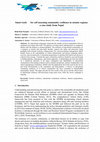
3rd European Conference on Earthquake Engineering and Seismology, 2022
An educational community represents the number of local communities from its catchment area along... more An educational community represents the number of local communities from its catchment area along with itself. The practice of using school infrastructures as temporary shelters after the disaster is common globally. The resilience of educational communities, as a response to natural and man-made hazards, requires the safety and protection being gradually built towards resilience enhancement. Pre-and post-disaster management efforts usually focus on the sustainability of school infrastructure and policies targeting shelter, recovery, and reconstruction. Community preparedness in dealing with shocks and stresses is related to this synergy. Towards this goal, community resilience should be assessed through a multidisciplinary, participatory, and critical approach. A methodology has been developed on a bottom-up inclusion of all major contingents and stakeholders of educational communities in developing countries such as students and parents, teachers, headteachers, and school management committees. Mobile and web applications have been used for the survey and result dissemination to the community and policymakers. A Survey of educational community resilience of 15 school communities has been concluded in Namobuddha municipality, Nepal. This paper presents the first results of the survey and the effectiveness of educational resilience self-assessment using smart tools, while the survey campaign is ongoing.
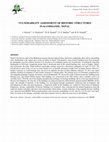
Nepal is located on a part of the Himalayan orogeny that has induced many destructive earthquakes... more Nepal is located on a part of the Himalayan orogeny that has induced many destructive earthquakes there and in surrounding areas. Kathmandu is the capital and a center of culture in Nepal. Unfortunately, many historic buildings have been damaged by earthquakes over the centuries because of its location in an earthquake-prone area. In particular, an earthquake impacting Kathmandu in 1934 had a magnitude greater than 8, destroying most of the cultural heritage sites, such as temples, shrines and monuments. Recently, Nepal suffered catastrophic damage caused by a destructive earthquake on April 25, 2015. The first priority in such events is to save as many human lives as possible and protect people from secondary disaster. However, historic structures in world heritage sites can never be replaced, because of their authentic character. To solve this major problem, detailed investigation of such historic structures is indispensable. The ultimate goal is to formulate comprehensive risk mi...

Structural response due to long duration of earthquake is still not confirmed as it amplifies mor... more Structural response due to long duration of earthquake is still not confirmed as it amplifies more or no any significant effects, after Great East Japan Earthquake, M9.0, 2011; research on effects of long duration ground motion on structural behavior increased. This study concentrates on finding the relationship of duration with different parameters of observed ground motion, simulation of long duration ground motion compatible with design response spectra in one part. One thousand five hundred forty nine ground motions observed in Japanese archipelago, recorded by NIED were analyzed. Most of the ground motions with single peak are taken into consideration. Duration of ground motion is taken as time between power intensity of 5% and 95% in all calculations. Relationship of duration with group time delay envelop, which is almost equivalent to envelop of ground motion, magnitude, epicentral distance etc. are
This chapter presents an overview of the construction technology and vulnerability of monumental ... more This chapter presents an overview of the construction technology and vulnerability of monumental masonry constructions in Nepal. The main administrative center is considered as a case study building and in situ and laboratory test results are presented to characterize the masonry construction that is native to Nepal but has similarities with Greco-Roman features. The damage observations during the Gorkha earthquake are presented and various failure mechanisms are described in this contribution.
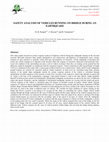
This study mainly focused on seismic response analysis of highway vehicles during the earthquake ... more This study mainly focused on seismic response analysis of highway vehicles during the earthquake running on the elevated structure. Elevated structures those mainly dominated in city expressways and highways in mountainous areas; seismic response of such structures is spatially varied with type and properties of structures. Actual earthquake acceleration that excites the vehicle running on it, depends on the location where the response of structures subjected at that particular time. Local soil condition of the surrounding area play a role in vehicle excitation when they are running on the ground but that difference might be negligible in comparison with the structural response. Virtual symmetrical cable-stayed bridge of length 1330 m is considered in the study with a central span of 580 m between two central towers. Kobe and El Centro earthquake ground motions are selected for structural analysis. Nodal responses on deck level are calculated using finite element analysis of the mod...
Geoenvironmental Disasters, 2020
This paper briefly discusses on the recent scenario in sustainable development goals and disaster... more This paper briefly discusses on the recent scenario in sustainable development goals and disaster risk reduction initiatives. Recent reports state that achievement of the target of SDG on 2030 is questionable however several strategies are placed internationally and locally. It raises the issue on paradigm shift in public awareness through citizen disaster science education, which will provide basic science behind any disaster of their locality that help in taking decisions in reducing exposure, improving preparedness and reaction, response and recovery to any disaster.
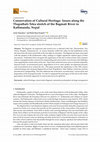
Heritage, 2019
The Bagmati, an auspicious and sacred river, is adorned with Ghat, Dharmashalas, Pati, Sattals, T... more The Bagmati, an auspicious and sacred river, is adorned with Ghat, Dharmashalas, Pati, Sattals, Temples, Brahmanaal etc. at various stretches within the valley for the facilitations of the devotees from the daily ritual bath to the last right of cremation. The Bagmati has been associated with the peoples of the Kathmandu valley, making it a highly significant cultural space of their devoutness. Authorities fail to recognize the significance of the site in terms of time, lack of proper policies, management plan, resources for safeguarding and conservation; several issues and challenges arise regarding the conservation of the site. Apart from technical issues such as material originality, financial issues, environmental issues, degradation of river water quality, development pressure and encroachment have ruined the site. This paper presents the significance of the 19th century cultural heritage sites along the Bagmati River from Thapathali to Teku Dobhan, which has not been prioritiz...
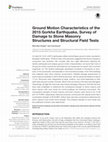
Frontiers in Built Environment, 2015
On April 25, 2015, a M7.8 earthquake rattled central Nepal; ground motion recorded in Kantipath, ... more On April 25, 2015, a M7.8 earthquake rattled central Nepal; ground motion recorded in Kantipath, Kathmandu, 76.86 km east of the epicenter suggested that the low-frequency component was dominant. We consider data from eight aftershocks following the Gorkha earthquake and analyze ground motion characteristics; we found that most of the ground motion records are dominated by low frequencies for events with a moment magnitude >6. The Gorkha earthquake devastated hundreds of thousands of structures. In the countryside, and especially in rural mountainous areas, most of the buildings that collapsed were stone masonry constructions. Detailed damage assessments of stone masonry buildings in Harmi Gorkha was done, with an epicentral distance of about 17 km. Structures were categorized as large, medium, and small depending on their plinth area size and number of stories. Most of the structures in the area were damaged; interestingly, all ridge-line structures were heavily damaged. Moreover, Schmidt hammer tests were undertaken to determine the compressive strength of stone masonry and brick masonry with mud mortar for normal buildings and historical monuments. The compressive strengths of stone masonry and brick masonry were found to be 12.38 and 18.75 MPa, respectively. Historical structures constructed with special bricks had a compressive strength of 29.50 MPa. Pullout tests were also conducted to determine the stone masonry-mud mortar bond strength. The cohesive strength of mud mortar and the coefficient of friction were determined.

The resilience of the educational communities and the school infrastructure is of paramount impor... more The resilience of the educational communities and the school infrastructure is of paramount importance to protect children from the various natural and man-made threats and to recover from the post-disaster trauma. However, after a natural disaster, it is typical for most efforts to focus on shelter, recovery and rapid reconstruction without due consideration of a wider framework for building back better school buildings and at the same time creating infrastructure, institutions and communities that are resilient to different shocks and stresses. Our current research which is conducted as part of a multidisciplinary project SAFER (www.safernepal.net), using Nepal as a case study area, is addressing the above need. In this context, the purpose of this paper is to present the the development of a tool for resilience assessment of educational communities. Central to this is the identification and organization of resilience indicators under four dimensions covering physical infrastructure, governance, curriculum and community structure. These are informed by recent developments and guidelines but more importantly, by findings from our continuing engagement with the major stakeholders amongst educational communities. Different mechanisms including surveys, semi-structured interviews and workshops were used to elicit stakeholders' knowledge and to inform the design of a set of questions for the evaluation of resilience. These questions range from physical infrastructure to environment, hazard awareness to preparedness, and social state to governance. All the questions with objective responses from each stakeholder are quantified and evaluated with reference to importance of the questions under respective resilience indicators. This ultimately leads to a resilience index together with a graphical view of the multi-dimension resilience indicators for the educational community. A mobile application with the above sets of questions and assessment methodology has been in parallel implemented to facilitate data collection during the survey within the educational community, as well as offering recommendations for resilience enhancement. The methodology and the tool can also be used for the self-assessment of resilience by the schools in developing countries and informing school improvement plans which are aligned to the Sendai Framework.

An earthquake of moment magnitude (Mw) 7.8 struck Nepal at 06:11 UTC on April 25, 2015. A field r... more An earthquake of moment magnitude (Mw) 7.8 struck Nepal at 06:11 UTC on April 25, 2015. A field reconnaissance was carried out immediately after the main shock. This paper presents the accelerograms and the geology of Nepal. The acceleration response spectra of the motions at the valley show a prominent amplification at the period of 5 sec. This paper describes the effects of local geology and topography on the damage severity during the earthquake. The damage patterns illustrate the strong influence of local geology conditions on the severity of the damage at many places, like soil amplification in Gongabu, Machhapokhari, Ramkot, Purano Naikap, areas along the major rivers in Kathmandu Valley with loose alluvium deposits, and ridge effects on the Swayambhu Nath hill and Chautara. The effect of low frequency amplification caused by the Kathmandu Valley basin is evident from the severe damage to well-designed tall buildings in Kathmandu. Severe damages including ground fissures and l...

The Government of Nepal issued a nationwide lockdown from 24 March to 21 July 2020, prohibiting d... more The Government of Nepal issued a nationwide lockdown from 24 March to 21 July 2020, prohibiting domestic and international travels, closure of the border and non-essential services. There were only two confirmed cases from 610 Reverse Transcription Polymerase Chain Reaction (RT-PCR) tests and no fatalities when the government introduced nationwide lockdown. This study aimed to explore the overall scenario of COVID-19 including spatial distribution of cases; government efforts, and impact on public health, socio-economy, and education during the lockdown in Nepal. We collated and analysed data using official figures from the Nepalese Ministry of Health and Population. Nepal had performed 7,791 RT-PCR tests for COVID-19, the highest number of tests during the lockdown. It has recorded its highest daily rise in coronavirus infections with a total of 740 new cases from the total of 4,483 RT-PCR tests performed on a single day. Nepal had reported a total of 17,994 positive cases and 40 d...
Journal of Japan Association for Earthquake Engineering
On April 25, 2015, Gorkha earthquake occurred about 80 km northwest of Kathmandu. In Patan, mason... more On April 25, 2015, Gorkha earthquake occurred about 80 km northwest of Kathmandu. In Patan, masonry structures collapsed in Durbar Square. The two-story masonry building that is the subject of this study, is about a 5-minute walk from Durbar Square. Although the building did not collapse, cracks were confirmed in several places. Microtremor measurements performed before and after the earthquake revealed that the natural frequencies of the building decreased. This study examined the factors that decrease the natural frequencies of buildings by seismic response analysis using ground motion estimated by the H/V spectrum ratio as input.
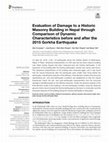
Frontiers in Built Environment
On April 25, 2015, a M w 7.8 earthquake struck the Gorkha district of Kathmandu, Nepal. In Patan,... more On April 25, 2015, a M w 7.8 earthquake struck the Gorkha district of Kathmandu, Nepal. In Patan, vibrational characteristics of a 300-year-old two-story masonry building near Patan Durbar Square had been measured prior the Gorkha earthquake. In the inspection of the building after the Gorkha earthquake, several new cracks were found. The vibrational characteristics of the building were measured again, and it was found that the natural frequencies after the earthquake were smaller than those before the earthquake, indicating the reduction of the stiffness. Finite element models of the structure representing pre-and post-earthquake conditions are established so that the natural frequencies match the pre-and post-earthquake measurements and the structural damage is identified based on the stiffness reduction. Finally, the dynamic analysis of the finite element model of the building in the pre-earthquake condition using the observed ground motion record during the Gorkha earthquake as the input is conducted, and the structural response of the building during the Gorkha earthquake is discussed.
Masonry construction in active seismic region , 2021
This chapter presents an overview of the construction technology and vulnerability of monumental ... more This chapter presents an overview of the construction technology and vulnerability of monumental masonry constructions in Nepal. The main administrative center is considered as a case study buildings and in-situ and laboratory test results are presented to characterize the masonry construction that is native to Nepal but has similarities with Greco-Roman features. The damage observations during the Gorkha earthquake are presented and various failure mechanisms are described in this contribution.

Scientific Reports, 2020
The COVID-19 pandemic has exceeded over sixty-five million cases globally. Different approaches a... more The COVID-19 pandemic has exceeded over sixty-five million cases globally. Different approaches are followed to mitigate its impact and reduce its spreading in different countries, but limiting mobility and exposure have been de-facto precautions to reduce transmission. However, a full lockdown cannot be sustained for a prolonged period. An evidence-based, multidisciplinary approach on risk zoning, personal and transmission risk assessment in near real-time, and risk communication would support the optimized decisions to minimize the impact of coronavirus on our lives. This paper presents a framework to assess the individual and regional risk of COVID-19 along with risk communication tools and mechanisms. Relative risk scores on a scale of 100 represent the integrated risk of influential factors. The personal risk model incorporates age, exposure history, symptoms, local risk and existing health condition, whereas regional risk is computed through the actual cases of COVID-19, public health risk factors, socioeconomic condition of the region, and immigration statistics. A web application tool (http://www.covira.info) has been developed, where anyone can assess their risk and find the guided information links primarily for Nepal. This study provides regional risk for Nepal, but the framework is scalable across the world. However, personal risk can be assessed immediately from anywhere.
Geoenvironmental Disasters, 2020
This paper briefly discusses on the recent scenario in sustainable development goals and disaster... more This paper briefly discusses on the recent scenario in sustainable development goals and disaster risk reduction initiatives. Recent reports state that achievement of the target of SDG on 2030 is questionable however several strategies are placed internationally and locally. It raises the issue on paradigm shift in public awareness through citizen disaster science education, which will provide basic science behind any disaster of their locality that help in taking decisions in reducing exposure, improving preparedness and reaction, response and recovery to any disaster.

Heritage, 2019
The Bagmati, an auspicious and sacred river, is adorned with Ghat, Dharmashalas, Pati, Sattals, T... more The Bagmati, an auspicious and sacred river, is adorned with Ghat, Dharmashalas, Pati, Sattals, Temples, Brahmanaal etc. at various stretches within the valley for the facilitations of the devotees from the daily ritual bath to the last right of cremation. The Bagmati has been associated with the peoples of the Kathmandu valley, making it a highly significant cultural space of their devoutness. Authorities fail to recognize the significance of the site in terms of time, lack of proper policies, management plan, resources for safeguarding and conservation; several issues and challenges arise regarding the conservation of the site. Apart from technical issues such as material originality, financial issues, environmental issues, degradation of river water quality, development pressure and encroachment have ruined the site. This paper presents the significance of the 19th century cultural heritage sites along the Bagmati River from Thapathali to Teku Dobhan, which has not been prioritized for safeguarding. This also addresses the restoration, reconstruction, conservation and preparation of the management plan. In order to safeguard the past legacy of this site for the future generations, the holistic approach of conservation has to be opted for.

Uploads
Papers by Rishi Ram Parajuli
compatible with design response spectra in one part. One thousand five hundred forty nine ground motions observed in Japanese archipelago, recorded by NIED were analyzed. Most of the ground motions with single peak are taken into consideration.
Duration of ground motion is taken as time between power intensity of 5% and 95% in all calculations. Relationship of duration with group time delay envelop, which is almost equivalent to envelop of ground motion, magnitude, epicentral distance etc. are shown in graphical and regression form. Group delay time envelop properties seems follow Cauchy distribution, where normal distribution is also in acceptable trend. Simulation of design ground motion compatible to given design response spectra were performed for observed earthquakes. Duration of simulated design ground motion then changed by varying the scaling parameter on group delay time envelop, where random phase was withdrawn, following the Cauchy distribution used as constant in every
iteration of spectral fitting. Long duration earthquake design ground motion was simulated. Simulated duration of earthquake ground motion with same location and scaling parameters gives better relationship than that observed ground motion duration had with same.
Simulated long duration earthquake design ground motion used in study of seismic response analysis of unreinforced brick masonry structures. Historical monuments that had been built in ancient time are mainly constructed with unreinforced brick or stone masonry in mud mortar with timber frames. Combating of such monuments is vital after seismic analysis of structure. Analysis of unreinforced brick masonry structure
with a band of concrete in between soil and brick foundation, for three different cases, indicates one good option of strengthening brick masonry structure. Changes in displacements and acceleration at top corners are compared. Modeling and numerical analysis of the structural system is based on the finite element method, considering 3D solid elements.